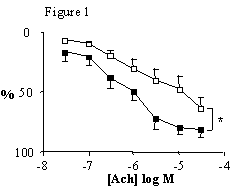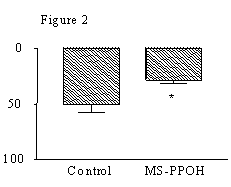| pA2 online © Copyright 2004 The British Pharmacological Society |
037P
University of Bath Summer Meeting July 2004 |
|
Selective inhibition of cyptochrome P450 epoxidation modulates endothelial dependent vasodilation
|
|
It is increasingly recognised that cytochrome P-450 (CYP) epoxidase metabolites including the Epoxyeicosatrienoic acids (EETs) are likely candidates for endothelial derived hyperpolarising factor (EDHF). A novel inhibitor, N-Methylsulfonyl-6-(2-proparygoxyphenyl) hexanamide (MS-PPOH) has been described that selectively inhibits the epoxidation of arachidonic acid (Wang et al, 1998), and thus inhibits vasodilation by the release of EETs. ATP is an important vasoactive mediator, which, at high concentrations, induces vasodilation predominantly via the release of EDHF (Stanford et al, 2001; Harrington and Mitchell, 2003). Here we have investigated the effects of MS-PPOH on ATP induced vasodilation in murine mesenteric arteries.
Male Black 6 mice (25 ± 1.9g) were killed by lethal exposure to CO2. First order arteries were isolated and mounted in wire myographs immersed in physiological salt solution (PSS). Arteries were equilibrated (30mins) and tensions normalised as described previously (Mulvany and Halpern, 1977). Arteries were incubated for 30 minutes with or without MS-PPOH (10-5M) before contraction with U46619 (10-8M) and dilation with either a acetylcholine (3x10-8–3x10-5M) or ATP (3x10-5M).
Inhibition of EET release by incubation with MS-PPOH significantly inhibited vasodilation by acetylcholine (figure 1) or by ATP (figure 2) in U46619 pre-contracted arteries.


Figure 1: Concentration response curve to acetylcholine in the presence (□) or absence (■) of MS-PPOH. Figure 2: Vasodilation in response to a single addition of ATP (3x10-5M) in the absence (control) or presence (MS-PPOH) of MS-PPOH (10-5M). Data is shown as a % of U46619 induced tone, ± SEM for n=3 experiments.
These results indicate that vasodilation induced by either ATP or acetylcholine in the murine mesenteric artery is mediated in part by CYP P-450 epoxidase metabolites. This data supports the hypothesis that EETs are important EDHFs in resistance arteries.
Harrington and Mitchell (2003). pA2online Vol.1 Issue 2 abstract 008P
Mulvany and Halpern (1977). Circ.Res. 41:19-26
Stanford et al (2001). BJP Jul 133(6): 825-32
Wang et al (1998). J. of Pharm. And Exp. Therapeutics. Vol 284(3): 966-973
This work was funded by the British Heart Foundation